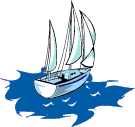Traveling the Route of the Triangular
Trade

Goals:
- Expand students’ knowledge about the triangular trade and
the distances the ships had to travel across the ocean.
- Use critical thinking to understand the effects on the
countries and to compare other modes of transportation now
available.
- Work with other students to measure distances and understand
and compare the triangular trade.
Resources:
- A map of the world with the triangular trade marked clearly;
specifically showing the ports of Bristol, England, the Ivory
Coast, Charleston, South Carolina and Salvador, Brazil.
- General background information about the triangular trade.
- The Atlantic Slave Trade by David Northrup (1994).
Lexington: D.C. Heath and Co.
(ISBN 0-669-33145-7)
- Africans in the Americas by Michael L. Conniff and
Thomas J. Davis (1994). St.Martin’s Press. (ISBN
0-312-04254-X)
- Internet
http://www.historychannel.com/exhibits/roots/where.html
http://dpls.dacc.wisc.edu/slavedata/index.html
http://dolphin.upenn.edu/~vision/vis/Mar-95/5284.html
Materials:
- Map of the world with scales of centimeters to miles and miles
to hours.
- Rulers
- Calculators (optional)
- Worksheet
Time:
Approximate time of one to two hours depending on the amount of
time it takes to complete the group worksheet and to discuss answers.
For best results, allow the students to take the critical thinking
worksheet home to finish. It would also be beneficial to grant time
in class to finish this worksheet.
Procedure:
- Ask students to divide into groups of three or four.
(optional)
- Hand out maps, rulers and worksheets.
- Explain the questions to the students and tell them the
approximate time the students should be done with the worksheet.
(see sheet)
- Students should begin to measure the distance between each
port in centimeters.
- After measuring the distance in centimeters, the students
should convert centimeters to miles using the scale found on the
map.
- After converting the centimeters to miles, the students should
convert the miles to hours traveled also using the scale found on
the map.
- The students should add all of the distances in miles from
each port together and also the hours. The students should
transfer the hours into days.
- Then the students should add the fourth port of Salvador,
Brazil. The students should use critical thinking to decide when
the best time to stop at this port, and how this would change the
distance and time of the whole trip.
- Students will then individually answer the critical thinking
questions in the classroom or at home.
Assessment:
- Each group should turn in the completed worksheet at the end
of the class.
- Each student must turn in their answers to the
critical thinking questions.
- Each student must submit a short paragraph regarding their
thoughts about the activity. Did they enjoy it? How would they
evaluate the rest of their group and themselves.
Curricular Strands and Major Concepts:
- Language Arts- writing skills in answering critical thinking
questions and evaluation paragraph, communicating with others in
their group.
- Math- converting centimeters to miles and miles to
hours. Also using the ruler to measure distances.
- Social Studies- primarily geography, using maps to analyze the
triangular trade. Also background knowledge of the historical
trade.
Possible Extensions:
- Find a new scale to use (such as centimeters changed to feet)
and go outside and have groups of students represent each port.
The distance between the ports and the estimation of where the
countries are, in relation to one another should be found by the
students. This will give the students a better perspective of the
distances between the ports.
- Have students calculate the time it would take to travel the
same distance by car, if it were ever possible, with the car
traveling at 55 miles per hour. 65 mph? 90 mph? 25 mph? Have the
students calculate the time walking at 3 miles per hour.
- Have students find the speed a bottle nose dolphin travels at.
How fast could it travel the distance from port to port? Is it
faster than the ship used on the worksheet?
Next Lesson
Previous Lesson
Table of Contents
Back to Main Page

